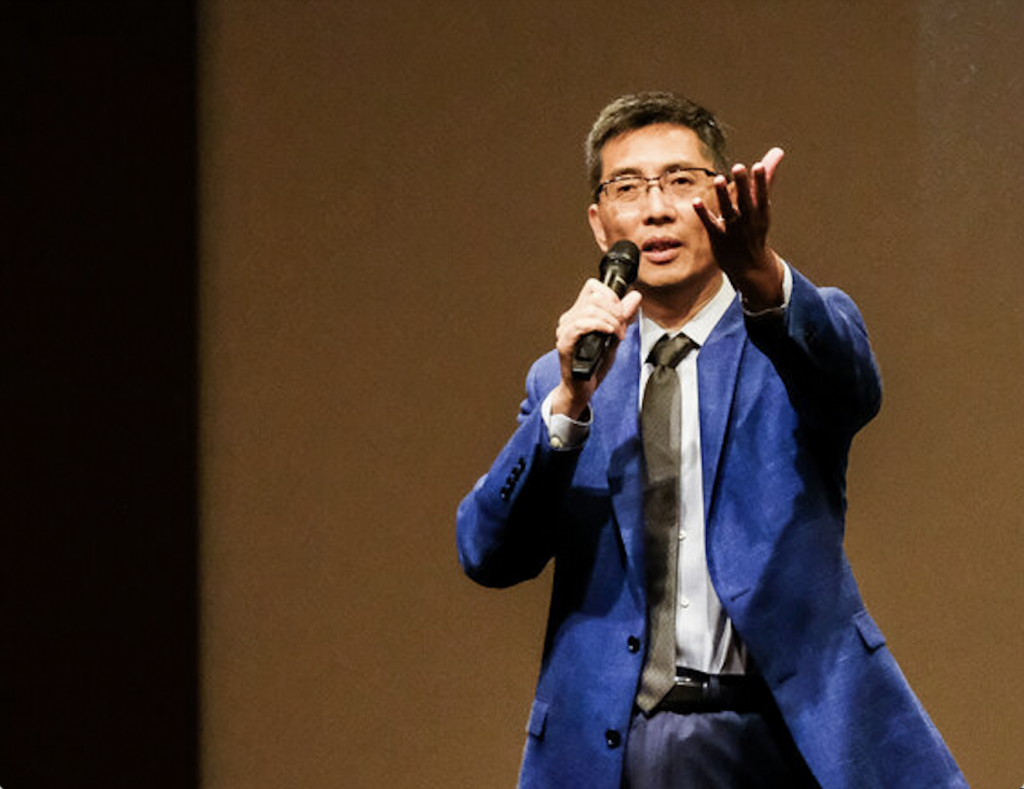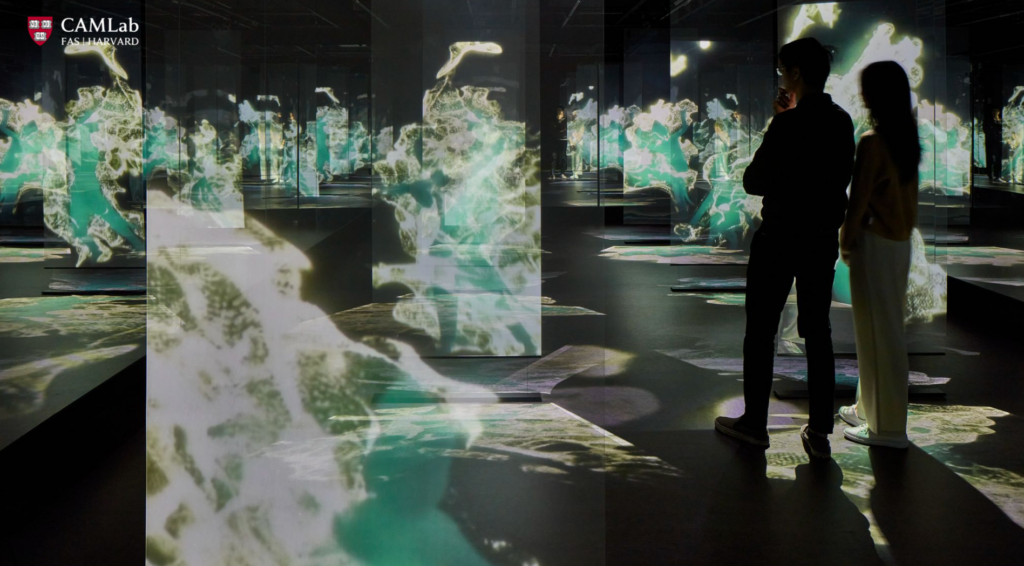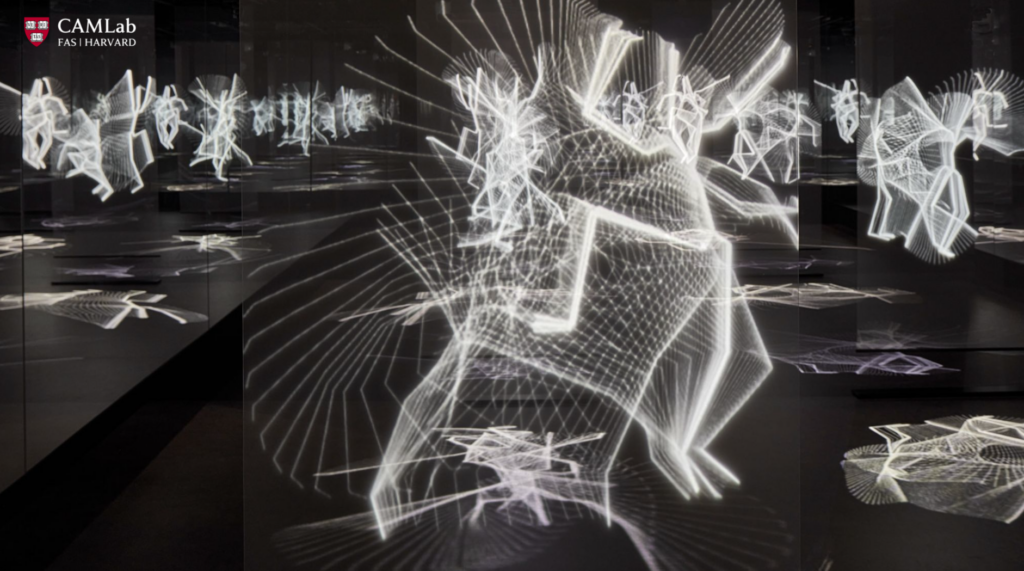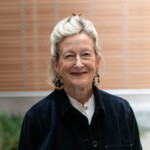Spotlight: Eugene Wang, Abby Aldrich Rockefeller Professor of Asian Art
Out of the pitch black, a painted clay Buddhist bodhisattva projected on transparent screens begins to shake and prance, coming to life as mesmerizing music fills the space. Suddenly, terracotta apsaras, or angel-like spirits, begin to dance around you as you wander through the room. You are as if inside a dream, surrounded by twirling, ethereal figures transported from the Buddhist caves in Dunhuang, along the Silk Road network in western China. The music quiets, and the bodhisattva and the apsaras return to stillness. Screens of Buddhist scriptures surround you.
In the next room, a snowy landscape appears on the walls. In an instant you are inside a Liao dynasty pagoda, soaring higher and higher through the wooden structure. Throaty Buddhist chanting reverberates, hitting a crescendo as you reach the pinnacle to face a statue of Buddha. You are experiencing this pagoda, physically located in Shanxi province, as the Buddhist practitioners intended back in the 11th century: With each new level as you sweep up through the wooden structure, you are moving closer to transcendence and enlightenment.
“We wanted to create an experience that is awesome, beyond words,” says Eugene Wang, Abby Aldrich Professor of Asian Art at Harvard University. “We are using modern technology to capture multiple dimensions, to help us imagine a universe in which everything can transform into something else.”

Welcome to CAMLab Cave, the thrilling, experimental project driven by machine learning and a team of brilliant Harvard art historians, artists, and techies at work in a basement space across the street from the Harvard Art Museum. Wang, an art historian who has written extensively about Buddhist art, is the mastermind behind the ambitious project. His team has been working for four years to create the immersive installations, which recently opened to the public. The acronym CAM stands for Cognition, Aesthetics, and Multimedia Storyliving, and Wang says he launched the Lab to find ways to express ideas through experience. Says Wang. “CAMLab uses digital media to stage cultural history.”
Wang is less interested in the specifics—the place, the date—than the human experience of the installations. “We chose Buddhist images not because of their religious value per se, but because of the special sensation they bring,” he says. “They block out everything that is extraneous and irrelevant. It’s about deprivation of senses to concentrate on something more essential.” Wang is fascinated by imagination and elements of the human experience that cannot be expressed in simple words. “If you are inside the Buddhist caves at Dunhuang, the paintings, the dimness, the palette of the paintings—there is no way a scholar can convey this through ordinary means,” says Wang. “The information you want to present far exceeds what linear writing can convey.”

Wang has the wide-ranging interests of a Renaissance man, driven by big questions about art, life, and human consciousness. And so it comes as no surprise that there he was on a recent afternoon, probing Chinese perceptions of death in a talk on his latest project: “Bardo Before the Bardo: Is There an Ancient Chinese Book of the Dead?” “What is it like to be dead?” Wang asks the audience, before sharing images depicting an afterlife spirit seeing his former deeds in a karma mirror from a 10th-century painting from Dunhuang, as well as the ritual choreography of the care of the dead in ancient China, as evidenced in the Tomb of the Marquis of Haihun in the year 59 BCE. “We’ve all heard of the Tibetan Book of the Dead, produced in the 14th century. But how far back did the tradition go?” Wang asks. It turns out, as he shows, the tradition went all the way back to ancient China.
Wang is also working with Professor Leonard van der Kuijp and two Fairbank Center An Wang post-doctoral fellows on an in-depth study of China’s Western Regions—including Western Tibet, such as Mount Kailash, the source of many ancient myths. The project, based in part on recent archaeological discoveries, does not subscribe to the view of a fixed disposition of Chinese civilization. “The broad western Regions are so pivotal in the formation of China and related parts of the world,” says Wang. There has been a longstanding habit, shared by many, of seeing China as an enclosed state of affairs, neglecting the fluid, pre-nation state realities of dynamic cultural exchanges. Instead of reinforcing “the fixed and self-enclosed essentialist view of Chinese civilization,” adds Wang. “We want to acknowledge the dynamic and exchange-driven reality. The narrative of the Western Regions is one of the projects premised on more fluid and less circumscribed view of Chinese civilization.”
Wang was born in Jiangsu, China, and came to the US in the 1980s. He says the intellectual climate of open-mindedness in 1980s China “opened up my mind” to the world at large. He came to study at Harvard, received his Ph.D. in Art History from Harvard in 1997, and joined the Harvard faculty in the same year. He became the Abby Aldrich Rockefeller Professor of Asian Art in 2005. Wang’s publications range from early Chinese art and archeology to modern and contemporary Chinese art and cinema. His prize-winning book, Shaping the Lotus Sutra: Buddhist Visual Culture in Medieval China, explores Buddhist worldmaking. Nowadays he says he is fascinated by the “cognitive study of art and consciousness as well as biocentric art that integrates visual, biological, and ecological systems.”
The CAMLab launched in 2018, and the team has since worked on more than 30 projects. The first was a grand digital choreography of the imaginary cosmos—from an aquatic underworld teeming with colossal whales to an imaginary wintery Northern Extremity reverberating with celestial hymns—behind the Mawangdui tombs (ca. 168 BCE) in Hunan province. That project is now being designed into a blockbuster museum exhibition. The team also has been working on a “Digital Luoyang” project that is reconstructing a virtual world of 6th century Luoyang, at the time the largest city in the world, before it was destroyed in a fire. Why Luoyang? “It was a very cosmopolitan city,” says Chenchen Lu, a Harvard Ph.D. candidate who is CAMLab’s Associate Director of Art. “It became a prototype of urban planning for thousands of years. It marked the turning point of Chinese culture!”
The current CAMLab immersive installation’s artistic and technical achievement results from years of work. The team consists of digital and art experts at Harvard and across the globe. The CAMLab design team brought animated apsaras to life through international partnerships. The project brought in participants from the world, including choreographers from UK, animators from France, and real-life dancers from the Beijing Dance Academy, who performed movements based on CAMLab’s research on dance-themed Dunhuang manuscripts and extrapolated from Dunhuang cave paintings. The dancers performed with electric nodes attached to their bodies, and the motion-captured data were then transformed with the help of AI into digitally generated dancing apsaras.

The design and production of the immersive installation also was an interdisciplinary endeavor, involving a team of art historians, architects, filmmakers, and media technologists. The scholars 3D-scanned the Shakya Pagoda of the Fogong Monastery from bottom to top (with special permission thanks to Tsinghua to move through the fragile structure) to reconstruct the building, joist by joist, using virtual reality technology. “CAMLab is an interdisciplinary platform that allows people from different backgrounds to collaborate effectively,” says Lu. The Buddhist chanting featured in the exhibition is derived from field recordings in Tibet, Taiwan, and Japan. The experience of climbing through the pagoda to eventually reach a light-dappled “cosmic Buddha” “invokes the concept of Indra’s Net, a metaphor for emptiness, in which a network of radiant jewels reflect each other to the extent that their individuality fades away,” says Simone Levine, Assistant Curator at CAMLab.
But the real genius of the CAMLab project is not just the technological and scholarly achievement: it lies in the fact that it connects digital scenography and data science, with the emotion and aesthetics of humanities in a cross-disciplinary form that focuses on experiential immersive storytelling. “We want to leave space for questions; we are not tied down to definitive interpretations,” says curator Levine.
Wang of course has big plans for CAMLab. He is bursting with enthusiasm about the project’s educational potential as he plans to share the new exhibition widely with students: “We want this to be the first truly immersive classroom in the world!”


